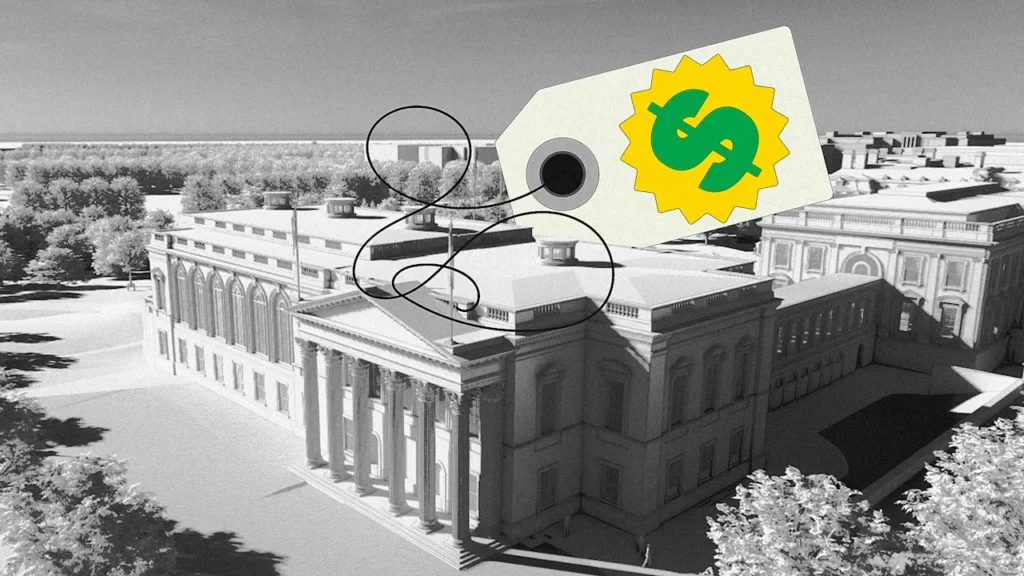
In what is somehow a real-life event and not an overwrought metaphor for the state of American democracy, earlier this week, work crews began tearing down the East Wing of the White House in order to make room for President Donald Trump’s planned 90,000-square-foot ballroom addition. Previously, Trump had said that the project would not “interfere” with the existing building, which now appears to be accurate only in the sense that by sometime this weekend, the East Wing will no longer exist.
The ballroom, which has an estimated cost of $250 million and a conspicuously uncertain completion date, will allow a president who feels most comfortable holding court at his chintzy Florida social club to enjoy a reasonable facsimile in D.C., complete with gold and crystal chandeliers, a gold-accented ceiling, and gold floor lamps.
For months, Trump has boasted that he wouldn’t pay for the ballroom’s construction using public resources, which is perhaps the plan’s only saving grace. But as the government shutdown enters its fourth week and millions of federal workers continue to go unpaid, the president has opted for a financing model that is grotesque and insulting in a different way: passing the tab along to a menagerie of wealthy opportunists eager to curry favor with a president who values personal fealty above all else.
Trump has fantasized for years, even before he entered politics, about being the man who expanded the White House, and reportedly reached out to the Obama administration in 2010 to offer to build a ballroom himself. He also claims to have approached the Biden White House with the same offer, which, given their history, is a conversation I assume would not include much by way of small talk.
Now that Trump is president for a second time, he’s been champing at the bit to follow through. Shortly after taking office, he mused about building his “beautiful, beautiful ballroom,” and in August, he told reporters who spotted him walking on the White House roof that he was looking for “more ways to spend my money for the country.” Trump has also said that managing the business of real estate is “relaxing” for him, an interesting insight into his priorities that is, in my view, bad news for anyone who hopes he’s working diligently to reopen the government he runs.
Last Wednesday, Trump hosted a dinner at the White House to court deep-pocketed prospective donors to underwrite the ballroom project, which he variously described to them as “phenomenal” and “totally appropriate.” The guest list, according to The New York Times, included representatives from many of the Big Tech brands that distanced themselves from Trump during his first White House tenure, and are now doing their best to make him forget about it: among others, Amazon, Apple, Google, HP, Meta, and Microsoft. Also well-represented at dinner was the crypto industry, whose luminaries are by now used to opening their checkbooks whenever Trump asks. Representatives from Coinbase, Ripple, Tether were in attendance; so were the Winklevoss twins, who now run the crypto exchange Gemini, and Charles and Marissa Cascarilla, whose company, Paxos, is the blockchain partner for PayPal.
Also listening to Trump’s pitch were a handful of big-name companies with lucrative government contracts, whose executives even more of an incentive to contribute to the president’s latest vanity project. Lockheed Martin, for example, holds multiyear defense contracts worth billions of dollars; the consulting firm of Booz Allen Hamilton does business almost exclusively with the federal government; Peter Thiel’s Palantir, which has been an integral part of the U.S. defense and intelligence infrastructure for years, recently inked a $10 billion contract to provide software support services to the Army for the next decade. Under this administration, it appears that an implicit condition of continuing to do business with the government is doing little favors for Trump upon request.
Even bit players in the MAGA universe who have good reason to believe they are already in Trump’s inner circle still felt compelled to show up: Kelly Loeffler, the former Georgia senator whom Trump appointed to lead the Small Business Administration; Benjamin Leon, Jr., whom Trump has nominated to serve as ambassador to Spain, and the Lutnick family, whose patriarch, Howard, is currently the Secretary of Commerce. On the one hand, it feels remarkable to me that a sitting Cabinet member would perceive no optics problems with allowing his boss to solicit his family for cash on an ongoing basis. On the other hand, given this president’s history of firing Cabinet members who do not conduct themselves at all times as vassals privileged to be in his presence, obediently attending is probably the prudent choice.
A final list of donors has yet to be released, but Trump says the project is fully funded. Per CBS News, Google, Booz Allen, and Palantir (among others) have all agreed to donate, as has Lockheed Martin, which has given somewhere north of $10 million. And in his remarks at the dinner last week, which was advertised on gold-lettered invitations exhorting recipients to help “establish the magnificent White House Ballroom,” Trump praised unnamed attendees for being “really, really generous,” and insinuated that some in the audience had given as much as $25 million.
A pledge form obtained by CBS News allows donors to “The Donald J. Trump Ballroom at the White House” to pay in a lump sum or on a three-part installment plan, and teases that they will be eligible for some sort of “recognition,” which could entail etched signage on the ballroom’s exterior. There is probably no better illustration of the Trump administration’s approach to governance than gut-renovating “the People’s House” by adding a co-branded, corporate-sponsored wing to it.
One of the larger confirmed donations so far reveals just how high the stakes can be for those whom Trump asks to give. About $22 million—roughly 10% of the total price tag—comes from the money YouTube agreed to pay Trump last month to settle a lawsuit he brought over the company’s decision to suspend his account in the aftermath of January 6. If you are keeping track at home, this means that a Silicon Valley giant that was kicking him off its platform four years ago is now waving the white flag in the form of an eight-figure check. At the dinner, Trump could not resist obliquely celebrating his reversal of fortune one last time: “It’s amazing the way a victory can change the minds of some people,” he said, according to The New York Times.
Officially, YouTube wrote its check to the Trust for the National Mall, a nonprofit involved in funding the ballroom’s construction. But the takeaway from this episode is pretty clear: The people and companies Trump solicits can either surrender what amounts to a rounding error on their balance sheets, thus earning Trump’s praise and enjoying a significant tax write-off. Or they can pass, and run the risk that Trump turns around and uses the legal system to shake them down for even more.
Wealthy people buying access to power is not new; for that matter, neither is wealthy people spending their money on decor that was already garish four decades ago. But the president’s preoccupation with rebuilding the White House in his image—and his supporters’ willingness to chip in—lays bare the extent to which decisions in this administration are getting made by people who have no idea what life is like in this country for those who are not billionaires. Trump’s government might not be open, but it is as for sale as it ever was, for anyone who can afford to pay the price.
